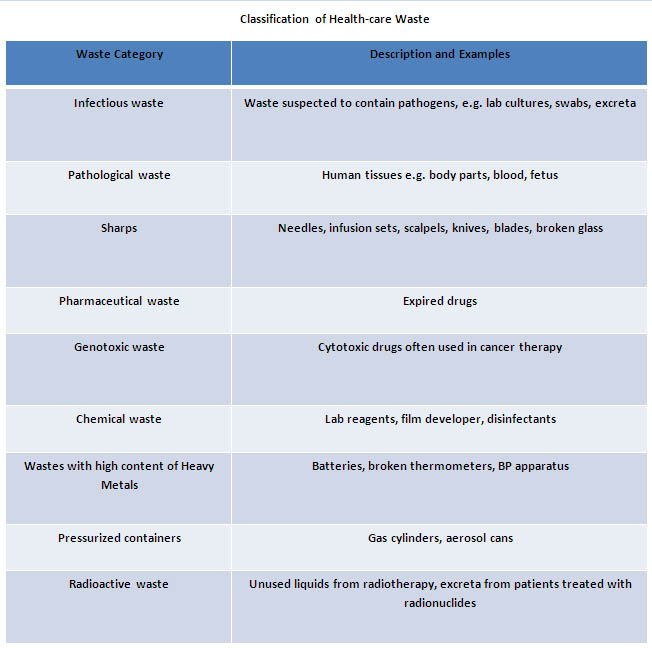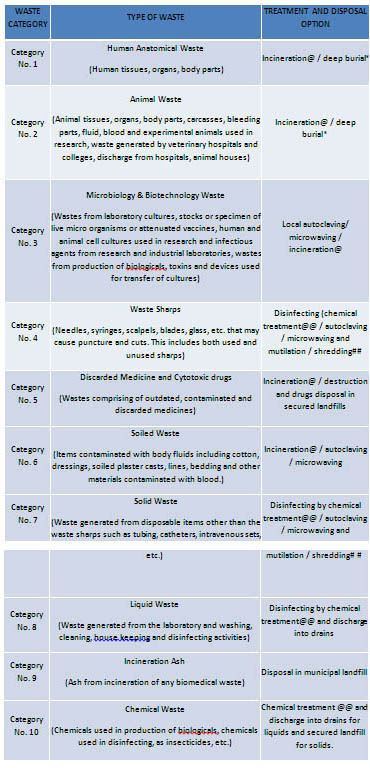For lecture click here: https://www.youtube.com/watch?v=tnLq4wqGbrk&list=PLm3g4QotzKaOWA7XjxS7sw...
Definition of Bio-medical waste (as per Biomedical rules (Handling and Management) rules, 1998), Min of Environment and Forests, GOI
Bio-medical waste means “any waste which is generated during
– the diagnosis,
– treatment or
– immunization of human beings or animals or
– in research activities or
– in production or testing of biologicals and
– Including categories as mentioned in schedule – 1”.
Biomedical waste poses hazard due to two principal reasons
– infectivity and
– toxicity.
Bio Medical waste consists of
• Human anatomical waste like tissues, organs and body parts
• Animal wastes generated during research from veterinary hospitals
• Microbiology and biotechnology wastes
• Waste sharps like hypodermic needles, syringes, scalpels and broken glass
• Discarded medicines and cytotoxic drugs
• Soiled waste such as dressing, bandages, plaster casts, material contaminated with blood, tubes and catheters
• Liquid waste from any of the infected areas
• Incineration ash and other chemical wastes
15 – 20% of the waste in a health care facility is BMW
Rest 80% of general health care waste is comparable to normal domestic waste and can be handled by the urban waste management system

Health Hazards of Healthcare Waste
• It contains:
– Infectious agents
– Toxic chemicals
– Sharps
– Genotoxic material
– Radio-active material
• Main groups at risk are:
– Doctors, nurses and paramedical workers
– Patients in health-care establishments
– Visitors to health-care establishments
– Workers in allied services e.g. laundry, waste handling and transportation and
– Workers in waste disposal facilities (including rag pickers)e.g. landfills and incinerators
Health Hazards of Healthcare Waste
• Hazard from infectious waste and sharps
– HIV
– Hepatitis B
– Hepatitis C
– Antibiotic resistant bacteria
• Chemical and pharmaceutical waste
– Corrosive
– Burns
– Explosives
• Genotoxic waste:
– Toxic manifestations depend upon
• Substance toxicity
• Amount exposed to and
• Time period of exposure
• Radio – active waste
– Headache, dizziness and vomiting after small exposure
– Serious health problems if exposure is high
• Public sensitivity:
– Public is very sensitive to the visual impact of health care waste
– Especially anatomical waste
• Hazard from infectious waste and sharps
– HIV
– Hepatitis B
– Hepatitis C
– Antibiotic resistant bacteria
• Chemical and pharmaceutical waste
– Corrosive
– Burns
– Explosives
• Genotoxic waste:
– Toxic manifestations depend upon
• Substance toxicity
• Amount exposed to and
• Time period of exposure
• Radio – active waste
– Headache, dizziness and vomiting after small exposure
– Serious health problems if exposure is high
• Public sensitivity:
– Public is very sensitive to the visual impact of health care waste
– Especially anatomical waste
Need of biomedical waste management in hospitals
The reasons due to which there is great need of management of hospitals waste such as:
• Injuries from sharps leading to infection to all categories of hospital personnel and waste handlers
• nosocomial infections in patients from poor infection control practices and poor waste management.
• Risk of infection outside the hospital for waste handlers and scavengers and sometimes general public living in the vicinity of hospitals.
• Risk associated with hazardous chemicals, drugs to persons handling wastes
• “Disposable” being repacked and sold by unscrupulous elements without even being washed.
• Drugs which have been disposed of, being repacked and sold off to unsuspecting buyers.
• Risk of air, water and soil pollution directly due to waste, or due to defective incineration emissions and ash.
Biomedical Waste Management Process
• Waste collection
• Segregation
• Storage
• Treatment
• Transport to final disposal site
• Final disposal
Categories of Bio-medical Waste in India
• Categorized as per the “Bio-medical waste (Management and Handling) Rules, 1988
• Into 10 categories
• The rules are prescribed by the ‘Ministry of Environment and Forests, G.O.I’
• Categories shown in the following table
– Bio medical waste should be segregated into containers/bags at the point of generation itself
– The color coding and the type of container should be as prescribed in the rules (shown in a following table)
– The containers should be clearly marked with
• the bio-hazard symbol and
• Cytotoxic hazard symbol
• The symbols should be prominent and NON-Washable


Notes:
1. Color coding of waste categories with multiple treatment options as defined in Schedule 1, shall be selected depending on treatment option chosen, which shall be as specified in Schedule 1.
2. Waste collection bags for waste types needing incineration shall not be made of chlorinated plastics.
3. Categories 8 and 10 (liquid) do not require containers/bags.
4. Category 3 if disinfected locally need not be put in Containers/bags.
Segregation
• Segregation refers to the basic separation of different categories of waste generated at source.
• Segregation is the most crucial step in bio-medical waste management.
• Effective segregation alone can ensure effective bio-medical waste management.
• The BMWs must be segregated in accordance to guidelines laid down under schedule 1 of BMW Rules, 1998 (i.e. categories 1 – 10).
How does segregation help?
– Segregation reduces the amount of waste needs special handling and treatment
– Effective segregation process prevents the mixture of medical waste like sharps with the general municipal waste.
– Prevents illegally reuse of certain components of medical waste like used syringes, needles and other plastics.
– Provides an opportunity for recycling certain components of medical waste like plastics after proper and thorough disinfection.
– Recycled plastic material can be used for non-food grade applications.
– Reduces the cost of treatment and disposal (80 per cent of a hospital’s waste is general waste, which does not require special treatment, provided it is not contaminated with other infectious waste)
– The bins and bags should carry the biohazard symbol indicating the nature of waste to the patients and public.
– Schedule III (Rule 6) of Bio-medical Waste (Management and Handling) Rules, 1998 specifies the Label for Bio-Medical Waste Containers / Bags as:
– Label shall be non-washable and prominently visible
Collection
• The collection of biomedical waste involves use of different types of container from various sources of biomedical wastes like Operation Theatre, laboratory, wards, kitchen, corridor etc.
• The containers/ bins should be placed in such a way that 100% collection is achieved. Sharps must always be kept in puncture-proof containers to avoid injuries and infection to the workers handling them.
Storage
• Once collection occurs then biomedical waste is stored in a proper place. Segregated wastes of different categories need to be collected in identifiable containers.
• The duration of storage should not exceed for 8-10 hrs in big hospitals (more than 250 bedded) and 24 hrs in nursing homes.
• Each container may be clearly labelled to show the ward or room where it is kept. The reason for this labelling is that it may be necessary to trace the waste back to its source.
• Besides this, storage area should be marked with a caution sign.
Transportation
The waste should be transported for treatment either in trolleys or in covered wheelbarrow.
Manual loading should be avoided as far as for as possible.
The bags / Container containing BMWs should be tied/ lidded before transportation.
Before transporting the bag containing BMWs, it should be accompanied with a signed document by Nurse/ Doctor mentioning date, shift, quantity and destination.
Special vehicles must be used so as to prevent access to, and direct contact with, the waste by the transportation operators, the scavengers and the public.
The effects of traffic accidents should be considered in the design, and the driver must be trained in the procedures he must follow in case of an accidental spillage
Personnel safety devices
The use of protective gears should be made mandatory for all the personnel handling waste.
• Gloves: Heavy-duty rubber gloves should be used for waste handling by the waste retrievers.
– This should be bright yellow in colour.
– After handling the waste, the gloves should be washed twice with carbolic soap and a disinfectant.
– The size should fit the operator.
• Aprons, gowns, suits or other apparels: Apparel is worn to prevent contamination of clothing and protect skin.
– It could be made of cloth or impermeable material such as plastic.
– People working in incinerator chambers should have gowns or suits made of non-inflammable material.
• Masks: Various types of masks, goggles, and face shields
• Boots: Leg coverings, boots or shoe-covers provide greater protection to the skin when splashes or large quantities of infected waste have to be handled.
– The boots should be rubber-soled and anti-skid type.
– They should cover the leg up to the ankle.
Treatment and Disposal Technologies for BMW
• Incineration
– Double – chamber pyrolytic incinerator
– Rotatory kilns
• Chemical disinfection
• Wet and dry thermal treatment
– High pressure steam
– Non-burn, dry thermal disinfection
• Microwave irradiation
• Land disposal
– Not to be dumped in open dumps
– Sanitary landfills should be used
• Inertization
– Mixing with cement and other substances before disposal
– Reduces the risk of migration into surface or ground water
Common Biomedical Wastes Treatment Facility [CBWTFs]
• The Common Biomedical wastes treatment facility, cast the responsibilities on municipal bodies to collect biomedical wastes/treated biomedical wastes and also provide sites for setting up of incinerator.
• One of India’s major achievements has been to change the attitudes of the operators of health care facilities to incorporate good HCW management and to purchase on-site waste management services from the private sector.
• Several medical facilities can use these Common Biomedical Waste Treatment Facility
Lecture available on: http://www.ihatepsm.com/resource/hospital-waste-management
